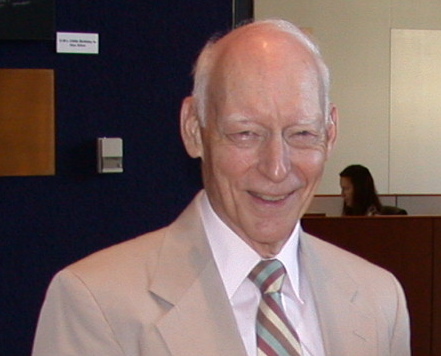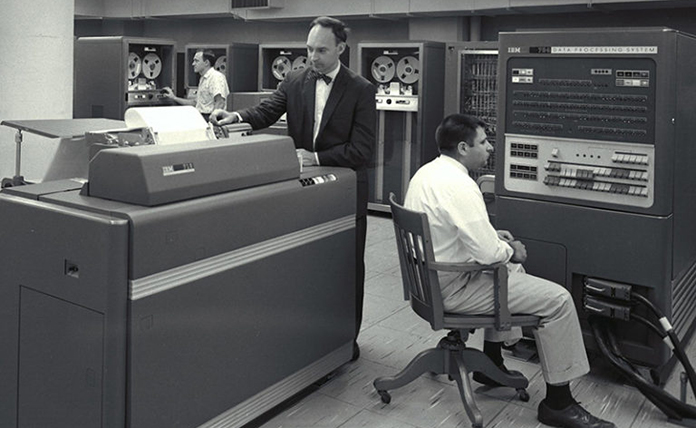Remembering Bruce Arden: U-M faculty member and past chair of Computer and Communication Sciences department

Computer scientist Bruce Arden, a former University of Michigan faculty member and chair of the early Computer and Communication Sciences department, passed away on December 8, 2021. He was 94. Arden made significant contributions to the field of computer science and to the adoption of computing practices at Michigan, with a goal of making programming more accessible to nonspecialists.
After serving in the US Navy as a radar technician from 1944–1946, Arden studied at Purdue University and graduated with a BS in electrical engineering in 1949. He began his computing career at General Motors, wiring and programming IBM computers, and soon moved to become a programmer at the University of Michigan’s Willow Run Laboratory. He later joined the U-M Statistical Research Laboratory as a researcher. In 1955, he received his master’s degree in mathematics at U-M.
In 1957, Arden and Robert Graham at the Statistical Research Laboratory began development of the Generalized Algebraic Translator (GAT), a compiler for the IBM 650 that simplified programming. GAT’s relative ease of programming greatly enlarged the user population at U-M and on other campuses where the language was adopted, and it helped make possible the use of the computer for classroom problems.
In 1959, Arden, Graham, and U-M mathematician Bernie Galler developed a successor to GAT, which they named MAD (Michigan Algorithm Decoder). MAD became used universally throughout U-M and also found acceptance at other places, such as MIT, the University of Maryland, and the Ford Motor Company. MAD made it possible to provide flexible computer service to an even larger number of users, again expanding the impact and accessibility of computing. MAD remained in service for decades, until mainframe computers were effectively replaced by personal computers.
Arden became affiliated as a researcher at the U-M Computing Center, which was formed in 1959 to advance research and the practice of computing at U-M, eventually becoming an Associate Director there.

In the early 1960s, as interest in computers grew amongst students at Michigan and an undergraduate program in computing took shape, Arden joined colleagues from various disciplines at the university in developing and teaching programming courses. His interest in academic computer science and engineering encouraged him to complete a PhD in Electrical Engineering at Michigan in 1965.
In the mid to late 1960s, Arden was involved in the design of the architecture and negotiations with IBM over the virtual memory features that would be included in what became the IBM System/360 Model 67 computer, and in the initial design of the Michigan Terminal System (MTS), a time-sharing operating system developed at the Computing Center which replaced the use of batch mode, punchcard-driven computing with a multiprocessing terminal-based system that gave each user the impression that there were no other users. MTS terminals were deployed across U-M, and the system remained in use at the university until 1996, and longer in other places. It is still used by a few hobbyists around the world. Once again, Arden had helped to usher in a new era of interactivity and accessibility in computing.
Arden became a professor in the U-M’s new Computer and Communication Sciences department, the university’s first department dedicated to computing, which was established in 1965. He served as department chair from 1972–1973.
In 1973, Arden left U-M to accept a professorship at Princeton University and to chair the EECS department there. In 1986, he went to the University of Rochester as its Dean of the College of Engineering and Applied Science. From 1992–1995, he also served as Rochester’s Vice Provost for Telecommunications and Computing.
Upon retiring in 1995, Arden moved back to the Ann Arbor area where he remained active and joined a group of former colleagues from the U-M Computing Center, the CCS department, and Merit who met regularly at the Old Town pub. When Covid interrupted that, he and his wife organized visits. Arden also maintained a home in Maine during his retirement.
Emeritus Research Prof. Peter Honeyman was for a time part of the group that met at Old Town, and he remembers Arden fondly. “Bruce was actually my department chair twice – as a Michigan undergrad and later as a Princeton grad student. He was kind and sweet, laughed a lot, but he also projected a formal mien that spoke of another generation. And quirky – in Princeton, he built a house whose room dimensions were all powers of two!
“It’s weird thinking that I’m one of the few people remaining who worked or studied with him. Back in the day, everyone at Michigan knew Bruce Arden.”
Read More
Wall Street Journal: Navy Radar Training Launched a Career in Computer Science
 MENU
MENU